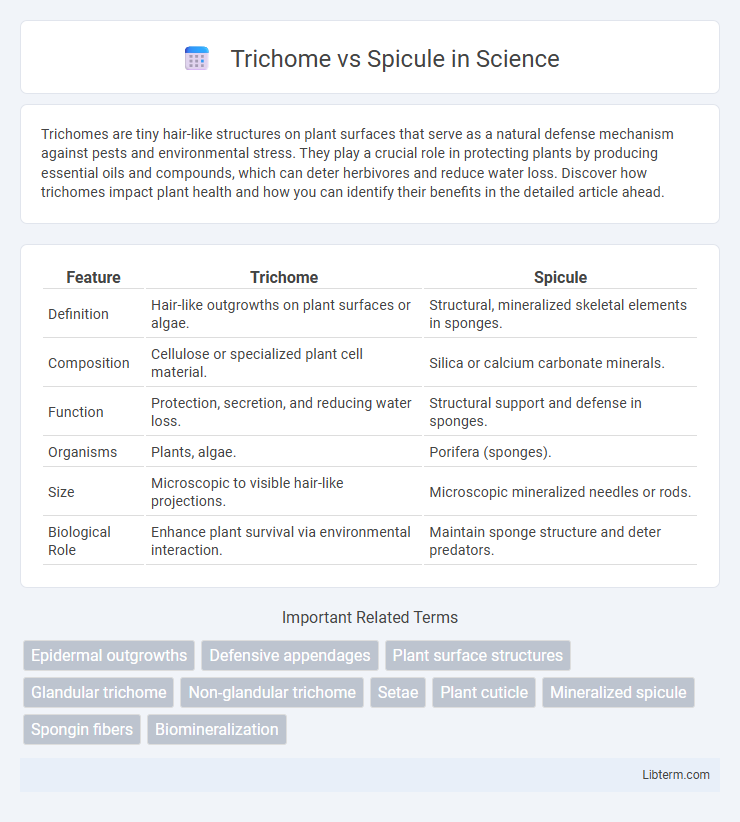Trichomes are tiny hair-like structures on plant surfaces that serve as a natural defense mechanism against pests and environmental stress. They play a crucial role in protecting plants by producing essential oils and compounds, which can deter herbivores and reduce water loss. Discover how trichomes impact plant health and how you can identify their benefits in the detailed article ahead.
Table of Comparison
| Feature | Trichome | Spicule |
|---|---|---|
| Definition | Hair-like outgrowths on plant surfaces or algae. | Structural, mineralized skeletal elements in sponges. |
| Composition | Cellulose or specialized plant cell material. | Silica or calcium carbonate minerals. |
| Function | Protection, secretion, and reducing water loss. | Structural support and defense in sponges. |
| Organisms | Plants, algae. | Porifera (sponges). |
| Size | Microscopic to visible hair-like projections. | Microscopic mineralized needles or rods. |
| Biological Role | Enhance plant survival via environmental interaction. | Maintain sponge structure and deter predators. |
Understanding Trichomes and Spicules
Trichomes are small hair-like structures found on the surface of plants, serving functions such as defense against herbivores and reduction of water loss. Spicules are microscopic skeletal elements found in marine sponges, providing structural support and deterring predators. Understanding the distinct roles and compositions of trichomes and spicules is essential for studies in botany and marine biology.
Key Differences Between Trichomes and Spicules
Trichomes are hair-like epidermal outgrowths found on plants, primarily serving as protective structures against herbivores and environmental stress, whereas spicules are structural elements made of silica or calcium carbonate found in marine sponges, providing support and defense. Trichomes vary in type, such as glandular or non-glandular, influencing their role in secretion or physical barrier formation, while spicules exhibit diverse shapes like megascleres and microscleres that contribute to sponge rigidity and predator deterrence. Key differences include their biological kingdom origin--plants versus sponges--and functional roles: trichomes focus on protection and secretion, while spicules primarily provide skeletal support and mechanical defense.
Structure and Morphology Comparison
Trichomes are hair-like outgrowths from the epidermis of plants, typically unicellular or multicellular, that serve protective and secretory functions, characterized by their elongated tubular or branched structures. Spicules, in contrast, are microscopic, needle-like skeletal elements found in sponges, composed of silica or calcium carbonate, exhibiting distinctive shapes such as monaxon, triaxon, or tetraxon based on their radiating axis arrangement. The structural difference lies in trichomes being organic epidermal appendages, while spicules are inorganic, mineralized components forming the internal support framework of sponge morphology.
Biological Functions of Trichomes
Trichomes are hair-like structures on plant epidermis that serve multiple biological functions, including protection against herbivores by producing toxic or deterrent compounds and reducing water loss through limiting transpiration. They also aid in reflecting excess light and trapping moisture, enhancing a plant's ability to survive in harsh environments. Unlike spicules, which are structural elements in marine sponges providing skeletal support, trichomes primarily contribute to defense and environmental adaptation in terrestrial plants.
Functional Roles of Spicules
Spicules serve as rigid, structural elements in sponges, providing support and deterring predators through their sharp, needle-like formations. These siliceous or calcareous structures enhance the sponge's defensive mechanisms and contribute to maintaining its overall shape and integrity. Unlike trichomes, which primarily function in plant protection and secretion, spicules are critical in marine sponge physiology for both mechanical reinforcement and environmental adaptation.
Occurrence in Plants and Animals
Trichomes are hair-like outgrowths primarily found on the epidermis of plant leaves and stems, serving functions such as protection against herbivores and reducing water loss. Spicules are structural elements typically found in marine animals like sponges, composed of silica or calcium carbonate, providing skeletal support and defense. While trichomes occur exclusively in plants, spicules are characteristic of certain animal species, representing distinct biological adaptations in different kingdoms.
Evolutionary Significance of Trichomes and Spicules
Trichomes and spicules represent distinct evolutionary adaptations in plants and sponges, respectively, enhancing survival through specialized functions. Trichomes contribute to plant defense, reducing herbivory and water loss, thereby promoting fitness in diverse environments. Spicules provide structural support and deter predators in sponges, reflecting an evolutionary response to ecological pressures in aquatic habitats.
Importance in Identification and Taxonomy
Trichomes and spicules serve as critical microscopic features for plant and sponge identification, respectively, with trichomes aiding in distinguishing plant species through their shape, size, and density, while spicules provide taxonomic clues in Porifera based on their mineral composition and morphology. Variations in trichome structure help taxonomists classify and differentiate species within angiosperms and gymnosperms, reflecting adaptations to environmental conditions and evolutionary lineage. In sponge taxonomy, spicule forms such as megascleres and microscleres are essential for defining genus and species, serving as reliable markers for phylogenetic relationships and ecological studies.
Applications in Industry and Research
Trichomes, microscopic hair-like structures on plant surfaces, have significant applications in agriculture for pest resistance and enhancing crop resilience, while spicules, silica-based skeletal elements in sponges, are extensively studied in biomaterials research for their strength and structural properties. In pharmaceuticals, trichomes contribute to the production of essential oils and secondary metabolites crucial for drug development, whereas spicules inspire advances in nanotechnology and regenerative medicine due to their unique mechanical and optical characteristics. Industrial sectors leverage trichome-derived compounds for natural pesticides and flavorings, while spicule morphology informs the design of lightweight, durable materials and biosensors.
Summary: Trichome vs Spicule
Trichomes are hair-like epidermal outgrowths found on plants that serve protective and sensory functions, while spicules are structural elements made of silica or calcium carbonate found primarily in sponges, providing support and defense. Trichomes vary widely in shape and size, influencing plant transpiration and herbivore deterrence, whereas spicules form intricate skeletal frameworks critical to sponge morphology. Understanding the differences between trichomes and spicules highlights their distinct biological roles, materials, and organisms of origin.
Trichome Infographic

 libterm.com
libterm.com